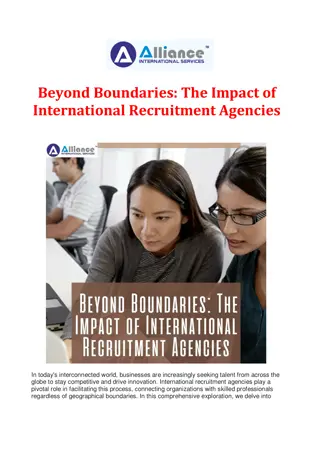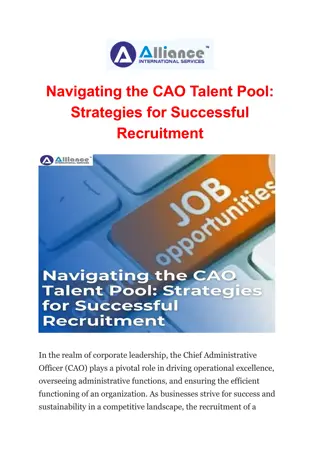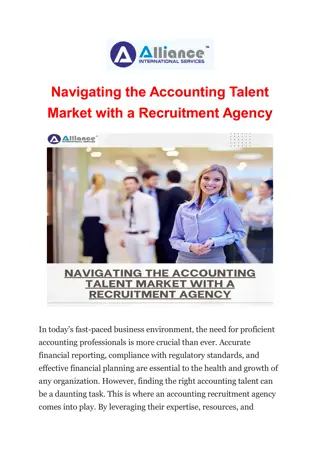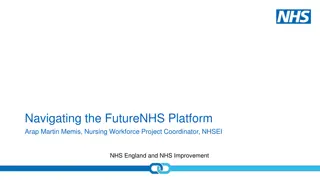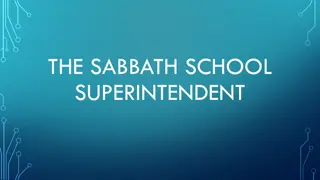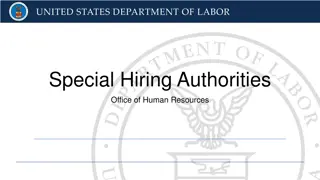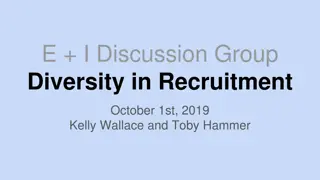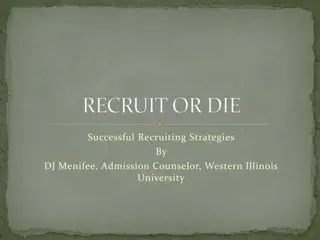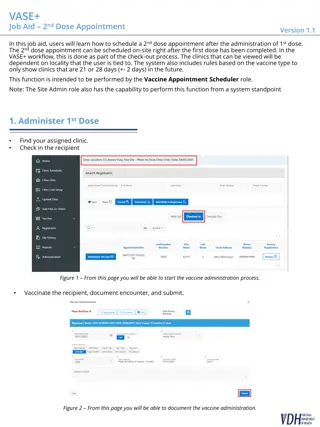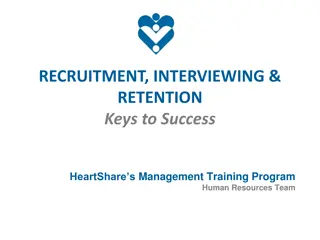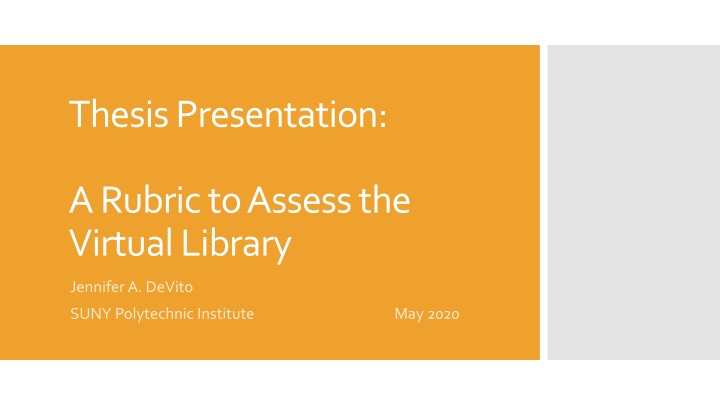
Superintendent Update: Recruitment and Successful Appointment
Update on recruitment progress with various positions filled and welcoming Laurie LaMondie as the new Jr./Sr. High School Principal. Acknowledgment of faculty, staff, and community members who contributed. A glimpse into upcoming presentations and discussions at BOE meetings focused on key educational topics.
Download Presentation

Please find below an Image/Link to download the presentation.
The content on the website is provided AS IS for your information and personal use only. It may not be sold, licensed, or shared on other websites without obtaining consent from the author. If you encounter any issues during the download, it is possible that the publisher has removed the file from their server.
You are allowed to download the files provided on this website for personal or commercial use, subject to the condition that they are used lawfully. All files are the property of their respective owners.
The content on the website is provided AS IS for your information and personal use only. It may not be sold, licensed, or shared on other websites without obtaining consent from the author.
E N D
Presentation Transcript
Thesis Presentation: A Rubric to Assess the Virtual Library Jennifer A. DeVito SUNY Polytechnic Institute May 2020
The library is often considered the heart of a college/university campus, offering collections, research support, instruction, and a space to study and work. Library websites have evolved over the last 20-30 years from static pages largely used to convey operational information to interactive and engaging spaces. This evolution supports the academic and research needs of users who are not on campus but also the trend of users increasingly seeking online resources and interactions. Introduction Through library websites, libraries try to provide a similar experience to users as they would have in the physical library. This includes access to sufficient resources and research assistance as well as instruction and workshops. The American Library Association Code of Ethics calls for equitable access for all users (Code of Ethics of the American Library Association, 2008).
Research question How can academic libraries assess their virtual libraries for engagement and dynamic content? What components make up an interactive website? How are these components represented in academic library virtual spaces?
Library websites began as communication and marketing tools; they now should be learning spaces that foster research, exploration, and community. Human-Centered Design (HCD) and Library 2.0 describe the characteristics that can be found in dynamic and interactive virtual libraries. Literature review Users emphasize interpersonal communication and services as being important in the research process. Libraries are trying to fill that need. Research shows that users want Simple, consistent, and personalized online services; Full access to resources; Remote access to library services (Mierzeckaet al., 2017)
Library 2.0 the application of interactive, collaborative, and multi-media web-based technologies to web-based library services and collections (Maness, 2006) Essential elements User-centered Includes multi-media Socially rich Communally innovative Human-Centered Design (HCD) a powerful alternative philosophy for systems design and broader educational and societal development (Cooley, 1999, p. 64) Characteristics include: Coherence Inclusiveness Malleability Engagement Ownership Responsiveness Purpose Panoramic Transcendence Theories
The virtual library is a user-centered virtual community (Maness, 2006) providing access to resources and research assistance as well as creating a community feel that users have come to expect in their library. The Virtual Library
Rubric combined characteristics from Human-Centered Design with the ones from Library 2.0 The homepages of 3 academic libraries were assessed using the rubric. Libraries are: members of the Association of Research Libraries R1 institutions (high level of research) Project Description Included the COVID-19 update pages for each library. Libraries are: Boston College Library (BC) University of Notre Dame s Hesburgh Library (ND) University of California Los Angeles Library (UCLA)
Characteristic (Theory) Definition Examples User can participate in the site; content is dynamic User is aware of the possibilities on the site Site s ability to conform to user s needs Site responds to users needs and encourages further exploration Dynamic content to enrich experience Site contains audio and video content Site allows for communication and interaction User-centered (Library 2.0) Clear navigation menu; user- friendly language Ability to personalize catalog or homepage; mobile-friendly site Access to research; connect with librarian; FAQs Coherence (HCD) Malleability (HCD) Purpose (HCD) Multi-media (Library 2.0) Audio/Video Screencasts, video tutorials Socially rich (Library 2.0) Online chat; online classes; feedback forms Accessibility features; mobile- friendly; information is discoverable Engagement (HCD) Encourages user participation Rubric Site responds to individual requirements and needs Responsiveness (HCD) Site is adaptive to changing needs, expectations, and demographics User is made to feel part of a community User feels they can create content and have ownership over parts of the system User can attain boundary knowledge and is able to use site effectively and competently Browsability of the site; user finds needed information and explores further Communally innovative (Library 2.0) Chat with librarians, submit resource recommendations Inclusive (HCD) Personalize pages; add tags/metadata Ownership (HCD) User locates information needed as well as additional sources Panoramic (HCD) Catalog encourages browsing; additional source recommendations Transcendence (HCD)
Table 2. Rubric used to evaluate library homepage Library: Characteristic (Theory) Definition Evidence on site Score User can participate in the site; content is dynamic User is aware of the possibilities on the site Site s ability to conform to user s needs Site responds to users needs and encourages further exploration Dynamic content to enrich experience Site contains audio and video content Site allows for communication and interaction Encourages user participation Site responds to individual requirements and needs Site is adaptive to changing needs, expectations, and demographics User is made to feel part of a community User feels they can create content and have ownership over parts of the system User can attain boundary knowledge and is able to use site effectively and competently Browsability of the site; user finds needed information and explores further X out of 3 User-centered (Library 2.0) Coherence (HCD) Malleability (HCD) Purpose (HCD) X out of 1 Multi-media (Library 2.0) Audio/Video X out of 2 Socially rich (Library 2.0) Rubric Engagement (HCD) Responsiveness (HCD) X out of 4 Communally innovative (Library 2.0) Inclusive (HCD) Ownership (HCD) Panoramic (HCD) Transcendence (HCD) Total X out of 10
Libraries Characteristic (Theory) BC ND UCLA User-centered (Library 2.0) Coherence (HCD) 2.75 1 3 1 2.5 1 Malleability (HCD) .75 1 .75 Purpose (HCD) Multi-media (Library 2.0) 1 1 0 .75 1 .75 Audio/Video .75 0 1 Results Socially rich (Library 2.0) Engagement (HCD) 2 1 2 1 1.75 1 Responsiveness (HCD) 1 1 .75 Communally innovative (Library 2.0) Inclusive (HCD) 3.5 1 4 1 3 .5 Ownership (HCD) .5 1 1 Panoramic (HCD) Transcendence (HCD) 1 1 1 1 1 .5 Total 9 9 8.25
A screenshot of a computer Description automatically generated Example
Overall, the 3 libraries scored high using this rubric. The sites were lacking in different areas. These results were expected because the sites are all from R1 institutions that are members of the Association of Research Libraries. Further assessment may include libraries from R2 & R3 institutions. Conclusion Only ND site allowed users to personalize their library experience directly from the homepage. Rubric needs to be refined to accommodate different levels of meeting the criteria.
Code of Ethics of the American Library Association. (2008). American Library Association. Retrieved 5/3/2020 from http://www.ala.org/advocacy/sites/ala.org.advocacy/files/content/proethics/cod eofethics/Code%20of%20Ethics%20of%20the%20American%20Library%20Ass ociation.pdf Cooley, M. (1999). Human-Centered Design. In R. Jacobson (Ed.), Information Design(pp. 59-81). MIT Press. References Images from Pixabay Maness, J. M. (2006). Library 2.0 Theory: Web 2.0 and its implications for libraries. Webology, 3(2). http://www.webology.org/2006/v3n2/a25.html Mierzecka, A., Kisilowska, M., & Suminas, A. (2017). Researchers' Expectations Regarding the Online Presence of Academic Libraries [Article]. College & Research Libraries, 78(7), 934-951. https://doi.org/10.5860/crl.78.7.934



